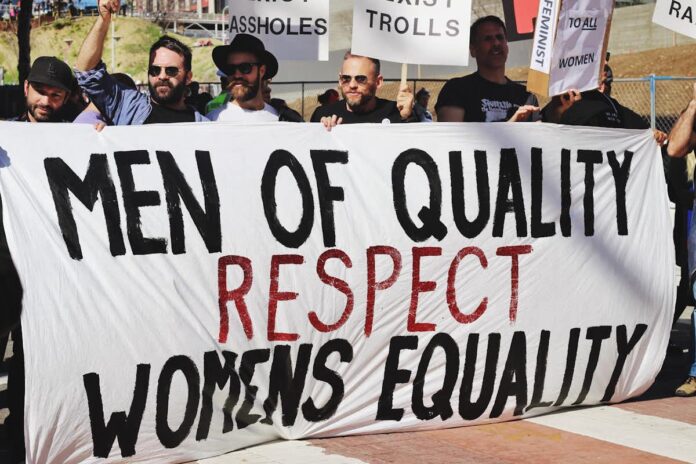The discourse surrounding feminism often predominantly focuses on the systemic inequalities faced by women. However, an important question arises: Do feminists recognize that men face sexism too? This inquiry necessitates a thorough exploration of how sexism manifests in society, addressing male experiences while concurrently evaluating the broader feminist philosophy. To engage critically with this question, we must investigate the definitions and manifestations of sexism, analyze feminist perspectives on masculinity, and untangle the complexities of male vulnerability within the gender paradigm.
Understanding sexism requires a nuanced examination of its various forms, from overt discrimination to subtler societal expectations and stereotypes. In traditional frameworks, sexism is largely conceptualized as a bias against women, indicative of structural and institutional power imbalances. Feminism has profoundly illuminated the myriad ways in which these inequities perpetuate oppression and disadvantage for women across cultures. Nonetheless, it is essential to interrogate whether the feminist critique of patriarchy acknowledges the ways in which men are also constricted by societal norms.
Sexism in its multi-faceted nature casts a wide net, ensnaring individuals of all genders. For instance, the rigid archetype of masculinity imposes expectations that may be detrimental to men’s emotional well-being. Men are often socialized to suppress vulnerability, exhibit strength, and eschew behaviors deemed ‘feminine,’ which can lead to mental health crises. According to the American Psychological Association, men are less likely to seek help for mental health issues, partly due to societal pressures to conform to traditional masculine norms. This is a clear illustration that while the feminist movement chiefly addresses the predicaments faced by women, it concurrently unveils elements of oppression experienced by men as a result of an inflexible gender binary.
The Toxicity of Traditional Masculinity
Exploring the roots of contemporary masculinity reveals that traditional notions of masculinity are inescapably intertwined with sexism. These ideals often manifest as a ‘toxic masculinity’ that valorizes aggression, emotional stoicism, and dominance over other genders. Importantly, toxic masculinity does not merely inflict harm upon women; it also constrains men, creating an environment where expressions of tenderness and vulnerability are stigmatized. This paradigm not only perpetuates negative stereotypes about men but also leads to cycles of violence and misogyny within society.
Moreover, men can be subjected to unique forms of sexism based on their actions or positions in life. For instance, when men pursue non-traditional careers or opt for roles such as primary caregivers, they may encounter prejudice or suspicion. Such experiences exemplify how the rigid structure of gender roles is a double-edged sword, inflicting damage on all parties involved.
Feminist Perspectives on Masculinity
Within feminist discourse, there exists an evolving recognition of men’s roles and the emotional labor required to challenge sexism. Some strands of feminism articulate the importance of male allies in the quest for gender equality. Such perspectives emphasize that men must confront their privilege and work actively to dismantle systems of oppression. By engaging with the feminist movement, men can gain awareness of their own vulnerability and challenge the very stereotypes that confine them.
Importantly, men acknowledging patriarchy doesn’t equate to the negation of women’s struggles; rather, it envisions an inclusive framework where men can participate in redefining masculinity in healthier terms. The intersectional approach within feminism advocates for leveraging male experiences to inform the broader fight against systemic sexism. In doing so, the movement challenges the insidious nature of sexism that perpetuates a hierarchy based on gendered expectations.
Male Vulnerability and Emotional Expression
Concurrently, the discussion of men’s experiences with sexism must involve a critical evaluation of emotional expression. Societal expectations have historically dictated how men should express—or suppress—their emotions. A study conducted by the Movember Foundation reveals that men often feel unable to communicate their mental health challenges, leading to alarming rates of suicide and substance abuse among men. This phenomenon highlights the paradox of gender norms; while feminism seeks to empower women, it also possesses the potential to elicit a broader dialogue around the emotional distress endured by men.
A tangible outcome of recognizing male vulnerability is the burgeoning interest in ‘men’s groups,’ spaces wherein men can explore their identities, feelings, and experiences. Such forums provide valuable support systems that facilitate open dialogue surrounding gender norms, enabling participants to challenge societal expectations collectively. This empathetic approach underscores how feminists can support the evolution of masculinity in a way that ultimately benefits both men and women, dismantling the shackles of archaic gender roles.
Bridging Feminism and Men’s Issues
Engaging with the idea that men face sexism does not necessitate a diminishment of women’s struggles; instead, it promotes a framework of solidarity and mutual support. The Feminist Men’s Network, for instance, advocates for men’s rights to be viewed through a feminist lens, emphasizing the importance of collaboration to dismantle patriarchal structures. Such initiatives serve as compelling examples of how men can work alongside feminists, creating a more equitable society.
Ultimately, a comprehensive understanding of sexism requires multifaceted engagement. It is paramount to recognize the various dimensions of oppression that men experience while concurrently advocating for the liberation of women. Feminism does not operate in a vacuum but rather as an interconnected movement that galvanizes individuals across the gender spectrum to envision a future free from the shackles of traditional gender constructs.
In conclusion, the question of whether feminists recognize that men face sexism too serves as a springboard for robust dialogue regarding the interconnectedness of gender issues. By fostering a more inclusive understanding of masculinity and confronting the toxic aspects of traditional gender norms, the feminist movement has the potential to catalyze social transformation that benefits all individuals, transcending the limitations of a binary perspective. As society progresses, it is imperative that the narratives of both women’s and men’s experiences of sexism be acknowledged and addressed collectively. In doing so, we can pave the way for a more equitable world where all individuals can embrace their identities without fear of scrutiny or oppression.





























